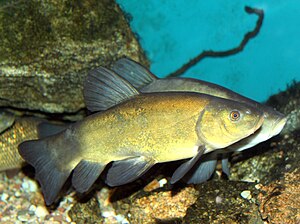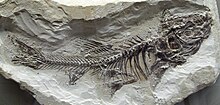Tench
| Tench | |
|---|---|

| |
| Scientific classification | |
| Domain: | Eukaryota |
| Kingdom: | Animalia |
| Phylum: | Chordata |
| Class: | Actinopterygii |
| Order: | Cypriniformes |
| Suborder: | Cyprinoidei |
| Family: | Tincidae Jordan, 1878 |
| Genus: | Tinca Garsault,1764[2] |
| Species: | T. tinca
|
| Binomial name | |
| Tinca tinca | |
| Synonyms | |
Thetenchordoctor fish(Tinca tinca) is afresh-andbrackish-waterfishof the orderCypriniformesfound throughoutEurasiafromWestern Europeincluding theBritish Isleseast intoAsiaas far as theObandYenisei Rivers.[3]It is also found inLake Baikal.[4]It normally inhabits slow-moving freshwater habitats, particularly lakes and lowland rivers.[5][6]
Taxonomy[edit]
The tench was formerly classified in the subfamilyLeuciscinaewith other Eurasian minnows, but more recent phylogenetic studies have supported it belonging to its own familyTincidae.[7][8]
Ecology[edit]
The tench is most often found in still waters with aclayormuddysubstrateand abundant vegetation.[9]This species is rare in clear waters across stony substrate, and is absent altogether from fast-flowing streams. It tolerates water with a lowoxygenconcentration,[3]being found in waters where even thecarpcannot survive.[9]

Tench feed mostly at night with a preference for animals, such aschironomids,on the bottom ofeutrophicwaters[10]and snails andpea clamsin well-vegetated waters.[9][11]
Breeding takes place in shallow water usually among aquatic plants where the sticky green eggs can be deposited.[3]Spawning usually occurs in summer,[5]and as many as 300,000 eggs may be produced.[12]Growth is rapid, and fish may reach a weight of 0.11 kg (0.25 lb) within the first year.
Morphology[edit]
Tench have a stocky, carp-like shape and olive-green skin, darker above and almost golden below. Thetail finis square in shape. The other fins are distinctly rounded in shape.[9]The mouth is rather narrow and provided at each corner with a very smallbarbel.[13]
Maximum size is 70 cm (28 in), though most specimens are much smaller.[14]A record fish caught in 2001 in England had a weight of 15 lb 3.4 oz (6.899 kg).[15]The eyes are small and red-orange in colour.[3]Females can reach weights of around 7 kg (15 lb), although 4 kg (8.8 lb) is considered large. Males rarely reach over 3 kg (6.5 lb).[3]Sexual dimorphism is strong, males can be recognised by having larger, more curved pelvic fins extending beyond the anus[16]and noticeable muscles around the base of these fins generally absent in females. Males also possess a very thick and flattened outer ray to the ventral fins.[13]Adult females may have a more convex ventral profile when compared with males.[14]
The tench has very small scales, which are deeply embedded in a thick skin, making it as slippery as aneel.[13]Folklorehas it that this slime cured any sick fish that rubbed against it, and from this belief arose the namedoctor fish.[12]

Golden tench[edit]
An artificially bred variety of tench called thegolden tenchis a popularornamental fishfor ponds. This form varies in colour from pale gold through to dark red, and some fish have black or red spots on the flanks and fins. Though somewhat similar to thegoldfish,because these fish have such small scales, their quality is rather different.[12]
Economic significance[edit]
Tench are edible, working well in recipes that would otherwise call for carp, but are not commonly consumed.[9]They are shoaling fish that are popular quarries forcoarse anglingin rivers, lakes and canals.[3]Tench, particularly golden tench, are also kept as ornamental fish in ponds as they are bottom feeders that help to keep the waterways clean and healthy.[17]
Angling[edit]
Large tench may be found in gravel pits or deep, slow-moving waters with a clayey or silty bottom and copious aquatic vegetation. The best methods and bait to catch tench are float fishing andledgeringwith a swim feeder using maggots, sweetcorn, pellets, bread, and worms. Fish over 1 kg (2 lb) in weight are very strong fighters when caught on a rod.[18]
References[edit]
- ^Freyhof, J. & Kottelat, M. (2008)."Tinca tinca".IUCN Red List of Threatened Species.2008:e.T21912A9339248.doi:10.2305/IUCN.UK.2008.RLTS.T21912A9339248.en.Retrieved19 November2021.
- ^Eschmeyer, William N.;Fricke, Ron & van der Laan, Richard (eds.)."Genera in the family Tinca".Catalog of Fishes.California Academy of Sciences.Retrieved27 November2020.
- ^abcdefFroese, Rainer; Pauly, Daniel (eds.) (2007)."Tinca tinca"inFishBase.May 2007 version.
- ^Maxim Anikin, ed. (2020)."Baikal lake fish, fish species of lake".Baikal Royal Safari.
- ^abB. Whitton (1982).Rivers, Lakes and Marshesp 163. Hodder & Staughton, London.
- ^"Tench".BadAngling.Retrieved2018-07-06.
- ^Schönhuth, Susana; Vukić, Jasna; Šanda, Radek; Yang, Lei; Mayden, Richard L. (2018-10-01)."Phylogenetic relationships and classification of the Holarctic family Leuciscidae (Cypriniformes: Cyprinoidei)".Molecular Phylogenetics and Evolution.127:781–799.Bibcode:2018MolPE.127..781S.doi:10.1016/j.ympev.2018.06.026.ISSN1055-7903.PMID29913311.S2CID49292104.
- ^"Family TINCIDAE Jordan 1878 (Tench)".The ETYFish Project.31 May 2023.Retrieved23 January2024.
- ^abcdeA. F. Magri MacMahon (1946).Fishlore,pp 156-158. Pelican Books.
- ^Perrow, M. R. (1996). "Factors affecting the habitat selection of tench in a shallow eutrophic lake".Journal of Fish Biology.48(5): 859–870.Bibcode:1996JFBio..48..859P.doi:10.1111/j.1095-8649.1996.tb01481.x.
- ^Bronmark, C. (1994). "Effects of Tench and Perch on Interactions in a Freshwater, Benthic Food Chain".Ecology.75(6): 1818–1828.Bibcode:1994Ecol...75.1818B.doi:10.2307/1939640.JSTOR1939640.
- ^abcA. Lawrence Wells (date unknown).Observer Book of Freshwater Fishes,pp 101-105. Frederick Warne & Co.
- ^abcOne or more of the preceding sentences incorporates text from a publication now in thepublic domain:Chisholm, Hugh,ed. (1911). "Tench".Encyclopædia Britannica.Vol. 26 (11th ed.). Cambridge University Press. p. 61.
- ^abG. Sterba (1962).Freshwater Fishes of the Worldpp 249-250. Vista Books, London.
- ^"Coarse Fish Records as at July 2021"(PDF).British Record Fish Committee.Angling Trust.19 July 2021.Retrieved22 January2024.
- ^Ignacio Fernández; Francisco Javier Toledo-Solís; Cristina Tomás-Almenar; Ana M. Larrán; Pedro Cárdaba; Luis Miguel Laguna; María Sanz Galán; and José Antonio Mateo (Mar 2021)."Skeletal Development and Deformities in Tench (Tinca tinca): From Basic knowledge to Regular Monitoring Procedure ".Animals.11(3). Basel: 621.doi:10.3390/ani11030621.PMC7996733.PMID33652872.
- ^Dick Mills (2000).Understanding Coldwater Fish,p 106. Interpet Publishing.ISBN1-903098-10-6
- ^A. Lawrence Wells (date unknown).Observer Book of Freshwater Fishes,pp 101-103. Frederick Warne & Co.

